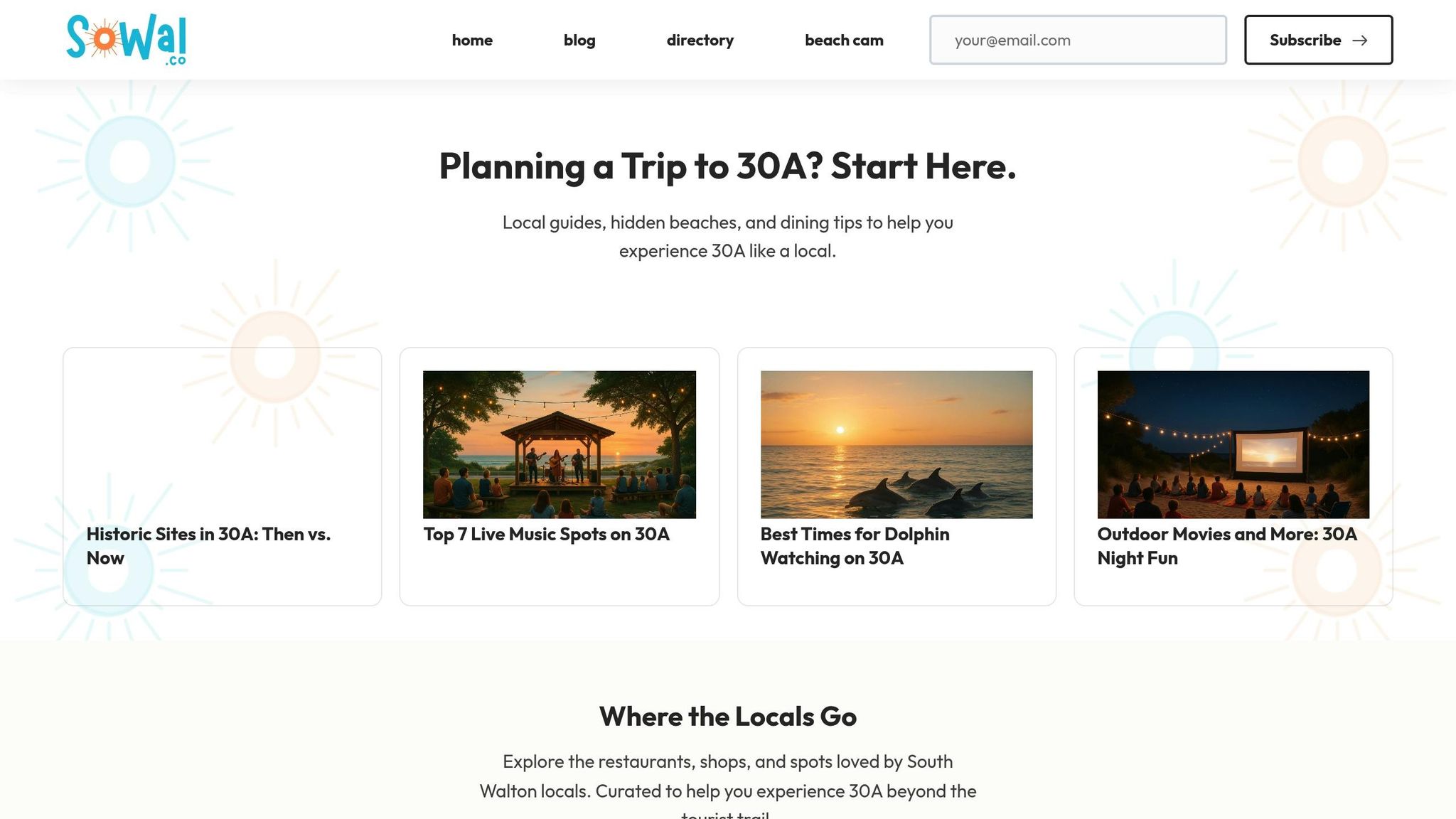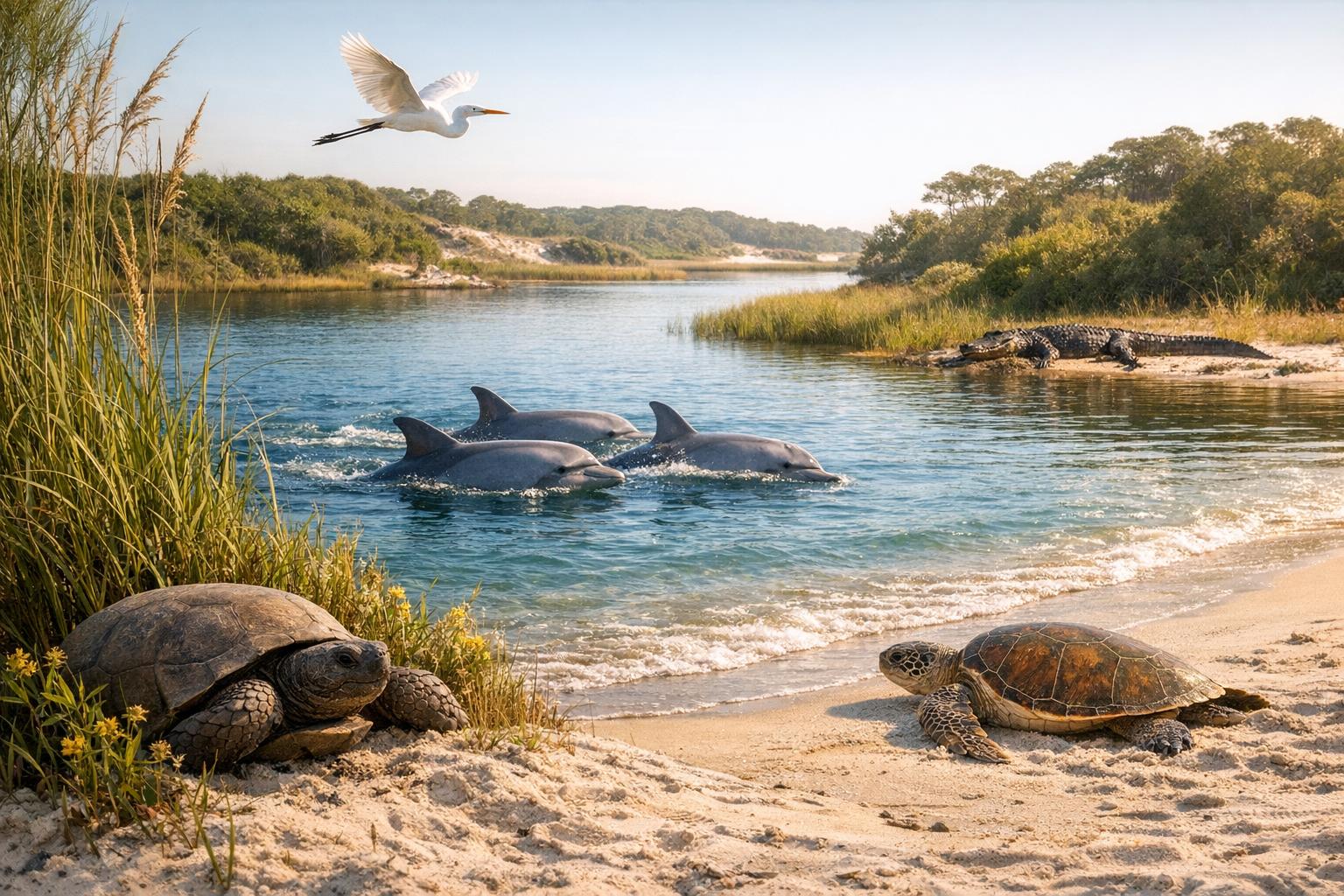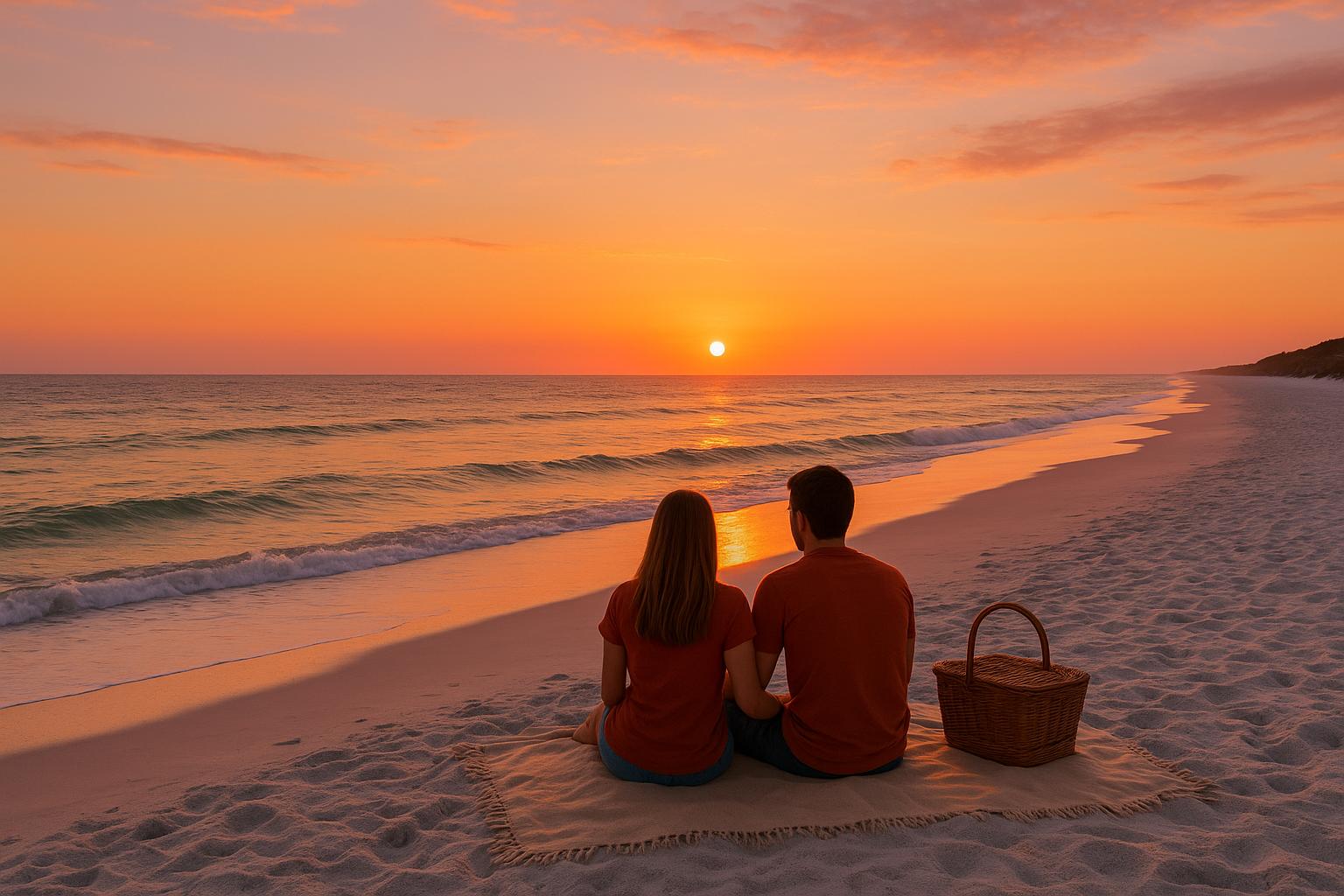Kayak photography along 30A in South Walton, Florida, is all about timing, location, and preparation. Whether you’re drawn to serene dune lakes or vibrant sunsets over the Gulf, here’s what you need to know:
-
Best Times of Day:
- Morning (Sunrise): Calm water, soft light, active wildlife, and fewer people.
- Evening (Sunset): Warm, dramatic light with stunning reflections and a peaceful atmosphere.
- Midday: Vibrant colors but harsher shadows and more activity on the water.
-
Seasonal Highlights:
- Spring & Fall: Mild weather, vibrant wildlife, and scenic landscapes.
- Summer: Bright greenery and extended daylight but high heat and crowds.
- Winter: Quiet waters, crisp air, and rare bird sightings.
-
Top Locations:
- Grayton Beach State Park: Perfect for sunrise over Western Lake.
- Eastern Lake: Magical mists and tranquil reflections in the morning.
- Lake Powell: Diverse landscapes and secluded spots.
- Cypress Springs: Clear, spring-fed waters ideal for detailed shots.
-
Key Tips:
- Use waterproof gear and polarized filters.
- Check weather and tide forecasts.
- Respect wildlife and stick to designated areas.
For more insights, visit sowal.co for local tips, weather updates, and hidden gems to elevate your kayak photography experience.
Kayak Photography Secrets: Capture Stunning Nature Shots on the Water! 🛶📸
Best Times of Day for Kayak Photography
Timing can make or break your kayak photography experience on 30A. The interplay of light, water conditions, and wildlife activity varies throughout the day, giving each time period its own distinct charm. Here's how morning, midday, and evening hours can shape your shots.
Morning: Sunrise Photography
Mornings are a dream for photographers. The soft, diffused light of sunrise reduces harsh shadows and brings out natural colors. The water is often calm and glassy, perfect for capturing stunning reflections. With fewer people around, you'll have the serenity to focus on pristine compositions. Wildlife is at its most active, and if you're lucky, you might even catch a magical mist rising from the water - Eastern Lake is particularly known for this.
Midday: Bright Lighting
Midday lighting has its pros and cons. On one hand, the bright light enhances color vibrancy and water clarity. On the other hand, it can lead to harsh shadows and glare, which can be tricky to manage. The increased boat and kayak traffic during these hours might also make it harder to find clean, open shots. To counter these challenges, consider using a polarizing filter to reduce reflections and always shoot in RAW to give yourself more flexibility during editing.
Evening: Sunset Photography
Evenings bring a completely different vibe. The golden hour light is warm and dramatic, casting long shadows and enriching water reflections with fiery hues. The waters tend to calm down again, and with fewer boats compared to midday, you can capture serene, mirror-like images. Locations like Grayton Beach State Park and Blue Mountain Beach are particularly stunning at this time, offering vibrant, picturesque scenes.
Comparison Table: Morning vs. Sunset
Here's a quick side-by-side look at how sunrise and sunset conditions differ:
| Feature | Morning (Sunrise) | Evening (Sunset) |
|---|---|---|
| Lighting Quality | Soft, cool, gentle | Warm, golden, dramatic |
| Water Conditions | Calm, glassy | Calm, reflective |
| Wildlife Activity | High | Moderate to high |
| Human Presence | Minimal | Moderate (less than midday) |
| Atmosphere | Peaceful, serene | Vibrant, romantic, dramatic |
| Main Challenges | Low light, early start | Quick light changes, occasional crowds |
Both sunrise and sunset provide incredible opportunities for kayak photography. Whether you lean toward the peaceful solitude of early mornings or the dramatic allure of golden evenings, your choice will depend on the mood you want to capture. Next, we'll dive into how seasonal changes can further influence your kayak photography on 30A.
Seasonal Considerations for Kayak Photography
Each season along 30A offers its own charm and challenges for kayak photography. Knowing how shifts in weather, wildlife activity, and crowd levels impact your experience can help you make the most of your time on the water.
Spring and Fall: A Perfect Blend
Spring and fall bring some of the most enjoyable conditions for kayak photography. With daytime highs in the mid-70s°F and mornings in the 50s°F, the mild weather and lower humidity make these seasons ideal for extended paddling trips.
Spring is teeming with life - migratory birds, turtles, and active fish create fantastic opportunities for nature shots. In fall, the landscape transforms as cypress and oak trees display golden and red hues, and wildflowers bloom along the shores. Eastern Lake’s morning mist adds a magical touch to your photos during these seasons. For a tranquil experience in March, spots like Cypress Springs offer abundant wildlife and minimal crowds, making it a photographer’s dream.
Summer: Vibrant Yet Challenging
Summer along 30A is alive with activity but comes with its own set of hurdles. High temperatures, often reaching the upper 80s to low 90s°F, combined with humidity over 70%, can make paddling and shooting physically demanding. However, the extended daylight - up to 14 hours - gives you more time to plan your shots.
The lush greenery and frequent sightings of dolphins and sea turtles are summer highlights, but crowded waterways and heavy boat traffic, especially during holidays, can disrupt serene photo opportunities. To capture the best summer images, aim for early mornings or late evenings when the light is softer. Don’t forget essentials like water, sun-protective clothing, and polarizing filters to tackle glare.
Winter: Peaceful and Atmospheric
Winter transforms 30A into a serene retreat, perfect for capturing moody, atmospheric shots. Daytime temperatures hover in the 60s°F, while nights can dip into the 40s°F, creating a crisp and refreshing environment. With fewer visitors, the waterways feel almost private, offering a quiet backdrop for your photos.
Though daylight is limited to 9–10 hours, the cooler air and reduced humidity result in sharper, clearer images. Winter also brings unique opportunities to photograph rare overwintering birds. Keep an eye on weather forecasts, as occasional cold fronts can cause sudden temperature drops. Dressing in layers ensures you’re prepared for changing conditions. For local weather updates and tips, resources like sowal.co can be invaluable.
sbb-itb-d06eda6
Top Local Spots for Kayak Photography
Building on the ideal times and seasons discussed earlier, these local gems on 30A offer an incredible variety of backdrops for kayak photography. South Walton’s 30A coastline is a treasure trove of photo-worthy locations, each with its own charm and character.
Grayton Beach State Park

Grayton Beach State Park is a must-visit for kayak photographers. Its standout feature, Western Lake, is a coastal dune lake that mirrors the sky beautifully during sunrise. The park’s designated dune access paths let you paddle right into the dunes, giving you unique angles to work with. Add in boardwalks, windswept sea oats, and sugar-white beaches, and you’ve got a photographer’s dream. For the best shots, arrive early to enjoy the warm, golden light and avoid the crowds. This local favorite, often highlighted on soWal.co, truly lives up to its reputation.
Eastern Lake
Eastern Lake is perfect if you’re seeking tranquility. Known for its calm waters, this spot is especially magical at sunrise when the morning mist adds a dreamlike quality. The stillness of the lake creates stunning reflections of the surrounding trees, making it a top choice for capturing serene, mirror-like images.
Lake Powell
Lake Powell, one of the largest coastal dune lakes in the area, offers endless possibilities for kayak photography. Its size means you can explore a variety of landscapes, from open water to marshy edges and forested areas. This diversity allows for wide, sweeping shots that showcase the region’s coastal ecosystem. With its vast layout, you can paddle to more secluded spots, giving you access to angles and scenes that smaller lakes can’t provide.
Cypress Springs
Cypress Springs is a haven for photographers drawn to clear, spring-fed waters and lush greenery. The water’s clarity is unmatched, making it ideal for capturing aquatic life and underwater reflections. The dense vegetation surrounding the springs offers opportunities for intimate nature shots, while the peaceful setting allows for focused, detailed photography. It’s a fantastic spot for blending botanical and landscape photography.
Comparison Table: Features of Top Locations
Here’s a quick breakdown of what makes each location special:
| Location | Best For | Water Conditions | Unique Features | Optimal Timing |
|---|---|---|---|---|
| Grayton Beach State Park | Wildlife, sunsets, and dune landscapes | Mirror-like reflections | Dune access paths, boardwalks | Early morning, golden hour |
| Eastern Lake | Reflection photography, peaceful scenes | Calm, still waters | Morning mist, serene reflections | Sunrise, early morning |
| Lake Powell | Expansive landscapes, diverse wildlife | Varies with vantage points | Large size, secluded areas | Early morning, late afternoon |
| Cypress Springs | Clear water shots, botanical studies | Crystal-clear spring water | Lush vegetation, underwater clarity | Mid-morning, spring/fall |
Each of these locations offers something special, whether it’s the dramatic dunes of Grayton Beach or the tranquil reflections of Eastern Lake. By pairing these stunning settings with the lighting and seasonal tips shared earlier, you’ll have everything you need to capture the essence of 30A’s natural beauty. Choose the spot that aligns with your creative vision and let the magic of 30A unfold through your lens.
Practical Tips for Kayak Photography Success
Now that you’ve nailed down the best times to shoot, it’s time to focus on protecting your gear and setting yourself up for success. A little preparation goes a long way in capturing those stunning kayak shots while keeping your equipment safe.
Gear You Need for Kayak Photography
When shooting from a kayak, safeguarding your equipment is non-negotiable. Start with a waterproof camera or housing; if you’re using a smartphone, invest in a waterproof case that still allows full touchscreen access. To store your electronics and accessories, go for dry bags rated for submersion - these typically range from $15 to $50.
Don’t forget the small but crucial accessories. Pack lens cloths to quickly clear water droplets, and use flotation straps to prevent losing gear if it takes an accidental plunge. Tether your equipment securely, and keep lens caps on when you’re not actively shooting. For sharp, professional-quality photos, set your camera to aperture priority mode at f/8–f/11 and aim for a shutter speed of 1/1000s or faster. Use a wide-angle lens (16–35mm) for sweeping landscapes and a telephoto lens (70–200mm) for capturing wildlife. Adjust ISO settings as needed to handle lighting changes and ensure stabilization.
Safety and Local Etiquette
Safety always comes first. Wear a U.S. Coast Guard–approved life jacket throughout your trip, and make sure to check weather and tide conditions before heading out. Let someone know your planned route to ensure peace of mind. Keep a respectful distance from local wildlife like birds and turtles, and steer clear of nesting areas to avoid causing disturbances.
Be mindful of your environmental impact by following Leave No Trace principles. Pack out all trash, avoid harming vegetation, and stick to designated launch points to protect delicate dune and marsh ecosystems. Opt for biodegradable sunscreen to safeguard water quality and ditch single-use plastics. Show courtesy to fellow paddlers by yielding when necessary, keeping noise levels down, and avoiding congestion at launch areas. These small actions not only enhance your experience but also foster a positive community vibe.
Planning Around Weather and Tides
Florida’s weather can shift in an instant, so keep a close eye on local forecasts for wind, rain, and lightning. Early mornings often provide the calmest conditions, perfect for capturing reflections and spotting wildlife.
Tide charts are your best friend when planning your outing. Incoming or high tide makes paddling smoother and gives you better access to shallow areas, while low tide can create challenges in maneuverability. Always check for small craft advisories before heading out to stay safe.
Seasonal changes also play a role in your preparation. Spring and fall offer mild temperatures and lower humidity, making for longer, more enjoyable trips. In summer, be ready for frequent afternoon storms by carrying extra water, wearing sun-protective gear like wide-brim hats and UPF clothing, and using waterproof cases for your phone. Winter outings call for dressing in layers and possibly using dry suits or splash gear to stay warm, as water temperatures can remain cool even when the air feels comfortable. With these preparations in place, you’re set for a smooth and productive paddle along 30A.
Resources on sowal.co

For more tips and insights, head over to sowal.co. You’ll find travel guides, event calendars, and recommendations for hidden beaches and launch points - ideal for avoiding crowds and finding those perfect photo spots.
The site also provides real-time weather updates, advice from local photographers and kayakers in community forums, and suggestions for outfitters and guided tours. Their event calendar can help you plan around busy times, while guides to secluded beaches might lead you to your next favorite photography location.
Conclusion
Capturing stunning kayak photos along 30A comes down to timing, location, and preparation. The golden hour - just after sunrise or before sunset - bathes your shots in soft, warm light, making it the ideal time to snap those picture-perfect moments. As highlighted earlier, these elements work together to shape an unforgettable photography experience.
Spring and fall are prime seasons for kayak photography, offering pleasant weather without the intense heat or crowded beaches of summer. Each location has its charm, from the glassy reflections of Eastern Lake to the striking dunes at Grayton Beach State Park, providing endless opportunities for creative shots.
To protect your gear and yourself, waterproof housings and thoughtful planning are essential, especially with Florida's unpredictable weather. Early morning launches often provide the calm, serene conditions needed to capture that perfect shot.
For insider tips, hidden launch points, and up-to-date weather information, sowal.co is your go-to resource. This guide connects you with the local photography community and uncovers lesser-known gems along 30A, giving you fresh perspectives far from the usual tourist spots. With their expertise, your paddle trip transforms into a safe and inspiring journey, blending adventure with creativity.
FAQs
What are the best tips for photographing wildlife while kayaking on 30A?
Photographing wildlife while kayaking along 30A offers an incredible opportunity to connect with nature and capture its beauty. To make the most of it, timing is everything. Early mornings and late afternoons are your best bet - wildlife tends to be more active, and the soft, golden light during these hours makes for breathtaking photos.
Move quietly and keep your motions smooth to avoid startling animals. This patience and care will often reward you with unforgettable moments.
Equip yourself with a waterproof camera or a sturdy protective case to keep your gear safe. A zoom lens is a game-changer, allowing you to snap detailed shots from a distance without disturbing the animals. And, above all, respect the local wildlife and their habitats. Keeping a safe distance ensures you’re not only protecting them but also yourself.
With these tips, you’ll be ready to capture the stunning natural wonders that make 30A’s waterways so special.
What’s the best way to keep my camera gear safe while kayaking on 30A?
When kayaking along 30A, keeping your camera gear safe is a must. Start with a waterproof bag or case to protect it from splashes or accidental dips in the water. For added security, consider using a floating strap - it’ll ensure your camera stays afloat if it accidentally ends up in the water.
Before you set off, take a moment to double-check that your gear is securely packed but still easy to reach. Staying aware of your surroundings and the water's behavior can go a long way in keeping your equipment safe and ready to capture the adventure.
When is the best time to go kayaking for photography on 30A?
The ideal time for kayak photography along 30A hinges on the season and time of day. For breathtaking lighting, head out during the golden hours - right after sunrise or just before sunset. These times provide soft, warm light that beautifully highlights South Walton's waterways. Early mornings are especially great, offering calm waters and fewer people, which makes capturing peaceful, undisturbed shots much easier.
When it comes to seasons, spring and fall stand out as the best. The weather is pleasant, and the scenery bursts with color - whether it's the fresh blooms of spring or the rich, earthy tones of autumn. Keep an eye on the weather forecast; clear skies and light winds make for the best kayaking and photography conditions. And don't forget to pack a waterproof bag to protect your camera gear while you explore the stunning coastal dune lakes and bayous along 30A!



